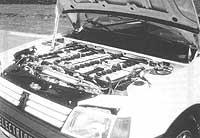Alternative fuel cells to the oil age?
2000/11/01 Imaz Amiano, Eneko - Elhuyar Zientziaren Komunikazioa Iturria: Elhuyar aldizkaria
Fuel cells, in principle, work like batteries. They generate electricity from hydrogen and oxygen. The reaction is electrochemical, that is, it is not combustion, where chemical energy is transformed into electricity and heat. The only waste or by-product generated is water vapor. Therefore, they produce electricity in the same way as batteries, but most batteries are recharged with electricity (both with the engine running and connected to the mains). Fuel cells, however, oxidize the outside fuel, that is, like combustion engines, must be incorporated from time to time.
In conventional combustion systems three steps are taken for the generation of electricity from fuel: first the chemical energy (fuel) is transformed into heat by combustion, then the heat energy is transformed into mechanical energy (in the thermal machine) by the pressure generated by the sand and finally the mechanical energy is transformed into electrical energy in the generators. However, in fuel cells, the step is unique and therefore the performance is better. The performance of the best combustion machines ranges from 30% to 40% in powers of around 1 MW. In small powers, in addition, performance decreases considerably. However, fuel cell performance is higher than 30%, even in a few watts.
Fuel cells are connected in series. Each battery in the series consists of two electrodes (anode and cathode) and electrolyte between both. The anode is a negative electrode where hydrogen is oxidized by the release of electrons. In the positive electrode, i.e. in the cathode, oxygen is reduced by taking the electrons released into the anode. The two electrodes are striated so that hydrogen and oxygen reach the entire anode and the reaction is facilitated. The function of the electrolyte is that positive charges go from anode to cathode or cathode negative to anode.
In theory the fuel is hydrogen, but it is difficult to obtain, accumulate and distribute pure and therefore expensive hydrogen. Although the ideal thing for energy to be truly renewable is the development of a technology that allows obtaining hydrogen without pollution, easy and cheap, in many cases fossil fuels (mainly methane) are used as a source of hydrogen. When done so, the hydrogen used is not pure, so the efficiency of fuel cells is reduced and some contamination occurs.
Fuel cell types
It has been commented on the function of the electrolyte, but they differ depending on the electrolyte containing the fuel cells.
Alkaline (AFC)
It is one of the oldest models. Potassium hydroxide solution (KOH) as an electrolyte. It is very sensitive to pollution, so it works much better with hydrogen and pure oxygen. Already in the 1960s it was used in US space missions, both for obtaining electricity and for access to drinking water. It is the space and military uses where it is most used.
Cation polymer (PEMFC or SPFC)
It is the type of fuel cells that are most being developed today, as several companies are researching and manufacturing cation polymer fuel cells. Electrolyte is an ion exchange membrane (fluorosulfopolymer). Anode fuels can be pure hydrogen, natural gas and methane, although pure hydrogen is best. The cathode is the oxygen of the air. It can be used in transport vehicles, power generation and portable systems. Several car companies have made their prototypes with this stack.
Phosphoric acid (PAFC)
It is also one of the oldest and most researched. The Japanese are the most advanced in researching and using such batteries. It uses phosphoric acid as an electrolyte. You can use methane as fuel, as from methane you can get hydrogen. The comburent is the oxygen of the air. The heat generated, about 200 C, can be used to heat air or water. You can also use methanol and ethanol as fuel. In any case, the carbon monoxide and hydrogen sulfide generated in the reform of the three must be prevented from reaching the anode to prevent a decrease in performance. Due to the time it takes to reach this operating temperature, it is not suitable for use in vehicles.
Molten carbonates (MCFC)
It uses as an electrolyte the mixture of alkaline carbonates (Li, Na and K). Anode fuels can be a synthesis gas or a reformed natural gas generated in carbon gasification. The cathode is the oxygen of the air. In the process heat is generated, usable in cogeneration (about 650 C), and water vapor, used in the own methane regeneration. Many see this type of battery as suitable systems for central generations.
Solid oxide (SOFC):
They contain itrium oxide and stable zirconium (YSZ) in the electrolyte. Its operating temperature is very high (700-1000 C) and the generated steam can be used to generate more electricity. It works with different fuels (pure hydrogen, methane, carbon monoxide...). The resulting discharge will depend on the fuel used. The fuel of the cathode is the oxygen of the air. It is used for generation and cogeneration plants.
Therefore, each type of fuel cell is suitable for different uses. On the other hand, although in almost all of them the ideal fuel is pure hydrogen, other fuels are used to obtain hydrogen (to the detriment of efficiency and the environment), which calls into question the nature of energy or renewable technology. However, this technology contaminates less than the current combustion engines.

Gai honi buruzko eduki gehiago
Elhuyarrek garatutako teknologia



